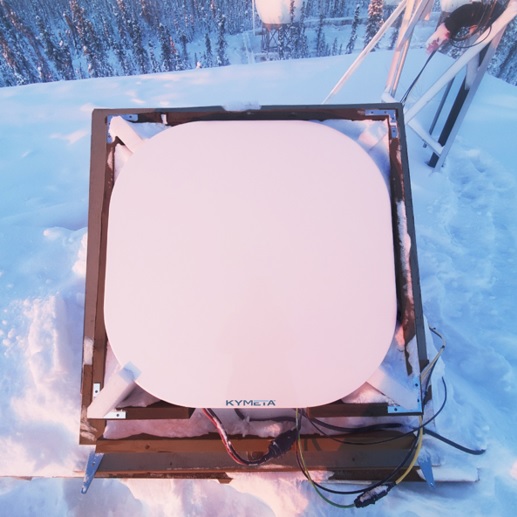
TORONTO and REDMOND, Wash. — Canadian satellite telecommunications company Kepler Communications today announced the successful demonstration of satellite antenna manufacturer Kymeta’s flat-panel u8 terminal (above) with LEO satellite acquisition, tracking and throughput measurements during extreme cold weather conditions in Canada’s north.
The collaboration is supporting Kymeta’s goal to develop future-proof solutions with a clear LEO upgrade path and compatibility with growing mega constellations, says the press release.
Kepler was selected in 2020 for an extended u8 beta trial in Inuvik, where frequent revisit times from Kepler’s LEO satellites combined with the local environment of cold weather, snow and ice provided a unique testing opportunity for Kymeta’s latest technology.
The u8 system is designed to work down to -40 degrees Celsius. During testing, Kymeta and Kepler were able to update software facilitating the testing of new algorithms in real time. These updates included updating the capabilities of on-board FPGA-based tracking receivers, which allowed for usage of channels more than two times larger than previous demonstrations, says the release.
“Results have demonstrated a significant increase in performance with lower latency, enhanced look angles and speeds that are approaching 10X faster than earlier products with higher throughput and total data passed,” reads the press release.
According to the release, testing results exceeded the companies’ expectations with average uplink and downlink speeds of 100 Mbps, providing the ability to transfer more than two gigabytes of data with each pass.
Initial testing was completed using linear polarization on the u8 terminal, and a future software upgrade will add circular polarization support which is expected to lead to additional increases in data transfer speeds, says the press release.
“Our recent testing and development efforts demonstrated not only the ability to move many more gigabytes of data than expected with each pass, but also the u8’s ability to operate in polar environments, where many of Kepler’s early adopters operate. With Kepler’s recently increased capacity the u8 can serve customers globally, pole-to-pole and all points in between,” said Wen Cheng Chong, Kepler’s chief technology officer and co-founder.
Just yesterday, Kepler launched two more satellites into its LEO constellation, which followed the launch of eight satellites in January.
For more on today’s announcement, please click here.
Image of Kymeta u8 terminal in Inuvik during testing with Kepler LEO satellites, courtesy of Kepler Communications.



